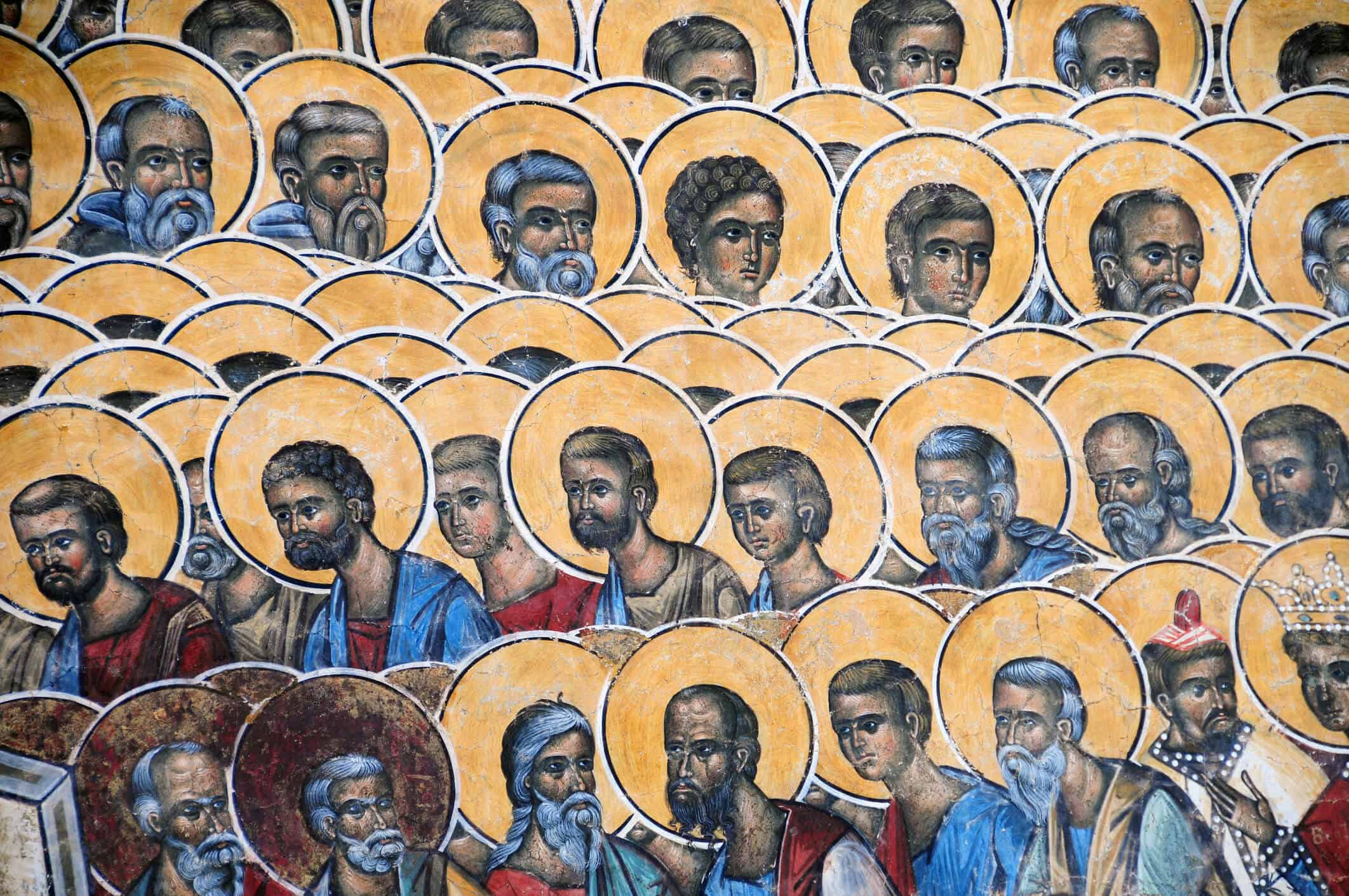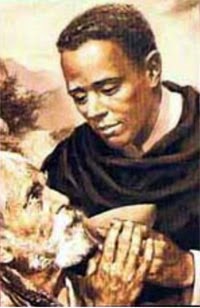
“I only cure you. It is God who heals you.”
St. Martin de Porres
November 3
St. Martin de Porres
Martin de Porres lived a life of fasting, prayer and penance as a Dominican lay brother. He was born born into poverty, the son of Ana Velasquez, a freed woman of Panama, and Juan de Porres, a Spanish grandee of Lima, Peru. His parents never married; Martin inherited the features and dark complexion of his mother, His father eventually abandoned Martin, his younger sister, and their mother. His mother apprenticed him to a barber-surgeon, where he learned how to cut hair, draw blood, care for wounds, and administer medicines. He was brutally ridiculed for his mixed parentage throughout his youth.
At 15, he joined the Dominican Convent of the Rosary in Lima as a lay brother, since descendants of Africans or Native Americans were not allowed to become full members of a religious order. He became a servant, but, because of his barbering experience, was eventually put in charge of the infirmary. His days were filled with nursing the sick and caring for the poor. He became well known for his tender care and amazing cures. Soon he was caring for the sick of the city and the slaves brought to Peru from Africa — not to mention the animals with which he is often pictured.
In 1603 at the age of 24, his religious Superior decided to disregard the law that “no black person may be received to the holy habit or profession of our Order” and Martin took vows as a member of the Third Order of Saint Dominic. Although he had no formal training, he was often consulted on theological questions by great churchmen of his day. Martin also founded an orphanage for abandoned children and slaves. He is unofficially called the patron of social justice. He is the first black saint from the Americas.
November 4
St. Charles Borremeo
Charles was born into an aristocratic family that was at the center of both ecclesial and political life in 1538. From an early age, Charles showed himself to be hardworking and sincerely attached to prayer. When presented with a family income at the age of 12, the young Count kept only the money required for his education and to prepare him for service to the Church. All other funds belonged to the poor of the Church and were to be passed along to them.
At twenty-two, he was made a cardinal by his uncle, the pope, and appointed to administer the Diocese of Milan. Though Charles wanted to go to his people— who had not had a resident bishop for over eighty years—he was kept in Rome, where he helped to drive the many reforms in the final session of the Council of Trent. Among the great reformers of the troubled sixteenth century, with St. Ignatius of Loyola, St. Philip Neri, and others, he was responsible for significant reforms in the Catholic Church, including the founding of seminaries for the education of priests.
When he was at last freed to go to Milan in 1564, he preached his first Mass in the city on Christ’s words from Luke 22;15: I have eagerly desired to eat this Passover with you before I suffer. Charles chose to live as simply his position allowed. “We ought to walk in front,” he told his priests, “and our spiritual subjects will follow us more easily.” When famine came, Charles incurred great debt helping the hungry. When the plague came, Charles prepared his soul for death and then led the people in a penitential procession, barefoot and with a noose around his neck (features that are often seen in the Church’s art). After about twenty years of unceasing labor for his people, Charles died of fever on November 3, 1584. His final words: Ecce venio, “Behold, I come!”
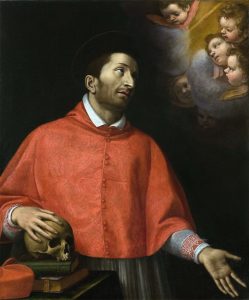
“You must realize that for us church men nothing is more necessary than meditation. We must meditate before, during, and after everything we do. In this way, all that you do becomes a work of love.”
St. Charles Borremeo
November 8
St. Elizabeth of the Trinity
Élisabeth Catez’s life was outwardly nondescript. Born to a French Army captain and his wife, she grew up in a tight-knit middle-class family that became even tighter after her father’s death when she was 7 years old. She was a lively, popular girl, extremely stubborn, given to fits of rage, but with great reverence for God. Elizabeth’s one accomplishment of note in childhood was a top prize for piano performance at the Dijon Conservatory.
But, on the day of her First Communion, Elizabeth learned from the mother superior of the nearby Carmelite convent that her name meant “House of God.” From this time, she became more and more aware of God’s presence in her soul. At fourteen, she made a vow of virginity, and at seventeen, she announced to her mother that she wanted to enter the Carmel. When her mother insisted that she wait four years, Elizabeth dutifully pursued an active social life, with pretty clothes, parties and dancing. But she also began praying daily to the Holy Spirit, her “Consuming Fire.”
In 1901, Elizabeth entered the Carmelite monastery in Dijon, France. “I can’t find words to express my happiness,” she wrote. Here there is no longer anything but God. He is all; he suffices and we live by him alone.” She was subject to periods of emotional darkness, and her spiritual director expressed doubts over Elizabeth’s vocation. However she was much admired for her persistence in pursuing the will of God and in devoting herself to the charism of the Carmelites. Two years later she professed her final vows, and subsequently became the spiritual director to many others. Her spirituality is considered to be remarkably similar to that of her contemporary and compatriot Discalced Carmelite sister, Thérèse of Lisieux, who was cloistered at the Carmel in Lisieux; the two shared a zeal for contemplation and the salvation of souls.
About this time, she showed the first signs of Addison’s disease, a rare, incurable disease whose side effects are painful and exhausting. She died two years after, in great physical and spiritual anguish. Her dying words were, “I am going to Light, to Love, to Life”
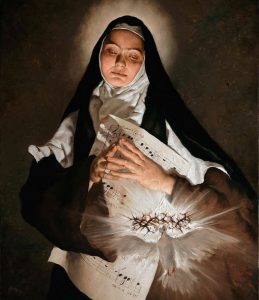
“Everything passes. In the evening of life, nothing remains but love. Everything must be done for love.”
St. Elizabeth of the Trinity
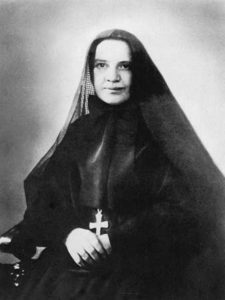
“Prayer is powerful! It fills the earth with mercy, it makes the Divine clemency pass from generation to generation; right along the course of the centuries wonderful works have been achieved through prayer.”
— Frances Xavier Cabrini
November 13
St. Frances Xavier Cabrini
Frances Xavier Cabrini was the first United States citizen to be canonized. Maria Francesca Cabrini was born on July 15, 1850 in Sant’ Angelo Lodigiano, Lombardy, Italy. She was the youngest of thirteen children, and only three of her siblings lived into adulthood. She was born two months premature, causing her to live most of her life in a fragile and delicate state of health.
She was attracted to religious life at a very early age, and was trained to be a teacher at a school run by the Daughters of the Sacred Heart. Because of her health, she was refused admission to the religious order which had educated her. She was asked to teach at an orphanage in Cadagono, Italy. She taught there for six years, gradually gathering a community of religious-minded women around her. She became Mother Cabrini after taking her final vows in 1877.
When the orphanage closed in 1880, she was asked by her bishop to found the Missionary Sisters of the Sacred Heart. Pope Leo XIII then sent her to minister to the many Italian emigrants in America. She traveled with six sisters to New York City and established schools, hospitals, and orphanages there. She became an American citizen in 1909 and eventually traveled to Europe, Central and South America and throughout the United States. She made 23 trans-Atlantic crossings and established 67 institutions: schools, hospitals and orphanages. In 35 years, Frances Xavier Cabrini founded 67 institutions dedicated to caring for the poor, the abandoned, the uneducated and the sick.
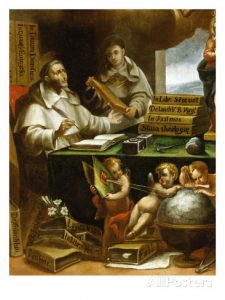
“Mary is the Divine Page on which the Father wrote the Word of God, His Son.”
— St. Albert the Great
November 15
St. Albert the Great
“The Universal Doctor”
As a result of the spread of Islam into Europe, Western philosophers and theologians became exposed to the teachings of the Greek philosophers, especially Aristotle. Most Christian philosophers and theologians viewed his writings with anything from suspicion to outright hostility. More than anyone else, Albertus Magnus – Albert the great – made Aristotle’s reason and logic a valuable tool for subsequent theologians, including his student, Thomas Aquinas.
Albert von Bollstadt was born in Bavaria at the beginning of the 13th century. He was the eldest son of a powerful and wealthy German lord, educated in the liberal arts at the University of Padua. His inquiring mind and wide range of interests made him the perfect student and scholar. In fact, it was that scope of knowledge and expertise that led to his being the only scholar in history to be named “the Great.” He was a keen observer of the natural world, demanding experimental proof and evidence for his writings. According to one biographer, he specialized in “everything created.” During his life, Albert wrote thirty eight volumes covering topics ranging from philosophy to geography, astronomy, law, friendship and love.
Albert entered the Dominican novitiate in Padua around 1229 and was ordained 4 years later. He became a lecturer for the Dominicans at Cologne. In 1245 Albert became a master of theology, the first German Dominican to achieve the title. He later went on to teach theology at the University of Paris; one of his students was the famous Thomas Aquinas who would also become a doctor of the Church and a saint, just as did his mentor, Albert. He later became a Dominican provincial, and ws appointed bishop of Regensburg for a short time. In 1259, Albert participated in the General Chapter of the Dominicans along with Thomas Aquinas and several other contemporary leaders of the Order. They created a program of study for the Dominican order and developed a curriculum for philosophy.
In his later years, Albert became renowned as a papal mediator. He mediated disputes between individuals as well as resolving a dispute between the people of Cologne and their bishop. He also founded Germany’s oldest university in that city. He was preceded in death by his beloved student, Thomas Aquinas, whose name he could not hear without weeping. Albert spent his last years defending the work of Aquinas which is among the most important work in the Church.
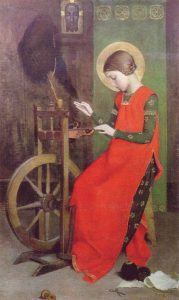
“We are made loveless by our possessions.”
— St. Elizabeth of Hungary
November 17
St. Elizabeth of Hungary
St. Elizabeth of Hungary was a 13th century princess, betrothed in infancy to Ludwig of Thuringia. Married to him in 1221, she nevertheless led an austere and simple life, building a hospital at the foot of the mountain on which her castle stood, tending to its sick personally.
She performed all types of charitable acts; she put herself at the service of widows, orphans, the sick, the needy. During a famine she generously distributed all the grain from her stocks, cared for lepers in one of the hospitals she established, kissed their hands and feet. For the benefit of the indigent she provided suitable lodging.
She took food to many of the poorest in the surrounding town, on a daily basis. Once when she was taking food to the poor and sick, Prince Ludwig stopped her and looked under her mantle to see what she was carrying; the food had been miraculously changed to roses.
Upon Ludwig’s death on crusade in 1227, her husband’s enemies hounded her out of the country, seizing the goods that were her due as a widow,. She was forced into the winter cold with her three children, one a baby. Fear of her enemies kept people from aiding her. She eventually found shelter in a pig sty. In 1228, after the return of Ludwig’s allies, she made arrangements for her children and renounced the throne to become a Third Order Franciscan. She lived in a mud hut and saw to all of her meager needs by spinning. She died at the age of 24.
November 23
Bl. Miguel Pro
Miguel Agustin Pro was born into a prosperous, devout family in Guadalupe de Zacatecas, Mexico in 1891. As a young boy he was, in equal parts, intensely spiritual, charitable, and mischievous. Inspired by the example of his older sister, who joined a cloistered order, he joined the Jesuit order as a novice in Mexico in 1911.
When governmental anti-Catholicism became widespread in 1914, the Mexican novitiate were forced to disband, and he and his fellow seminarians were ordered to flee to the Jesuit house in Los Gatos, California. He was to a seminary in Granada, Spain in 1915, where he resumed his studies. He was sent to Nicaragua to teach for 4 years, and then was sent to Belgium, where he was ordained in 1925.
The next year he was allowed to return to Mexico City by his Order. Shortly after he returned, the Mexican president Calles banned all public worship. Since he was not known as a priest, he used disguises to secretly minister to the people, celebrating Mass, hearing confessions, and helping the poor; even appearing in jail dressed as a police officer to bring Eucharist to condemned Catholics.
In 1927, when a bomb was thrown at President Calles from a car formerly owned by one of his two brothers, all three brothers were arrested. Without a trial, the two older brothers were sentenced to death by a firing squad. Calles made the execution public, hoping to show the brothers dying as cowards. But Padre Pro refused the blindfold and welcomed the bullets with his arms extended in the form of a cross, a crucifix in one hand and a rosary in the other. He forgave his executioners and, before he was shot, cried out, “Viva Cristo Rey!”
After his death, 40,000 Mexicans defied the government by lining the streets as Padre Pro was carried to his gravesite, where 20,000 more witnessed his interment. he was beatified in Rome on September 25, 1988, by Pope John Paul II as a Catholic martyr, killed in odium fidei (in hatred of the faith).
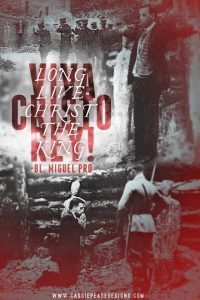
“We ought to speak, shout out against injustices, with confidence and without fear. We proclaim the principles of the Church, the reign of love, without forgetting that it is also a reign of justice. “
– Miguel Agustin Pro
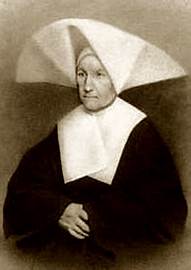
“If you listen, God will also speak to you, for with the good Lord, you have to both speak and listen. God always speaks to you when you approach him plainly and simply.“
Saint Catherine Laboure
November 27
Our Lady of the Miraculous Medal
November 28
St. Catherine Laboure
St. Catherine Labouré was born in Burgundy, France on May 2, 1806 as the ninth of 11 children. When she was 9 years old, her mother passed away, making Catherine responsible for the household. In an act of faith, she decided to replace the mother she had lost with her Heavenly Mother, Mary.
Growing up, Catherine was known for being a quiet and practical child, though she was extremely devout. A couple of years after her mother’s death, Catherine experienced a dream of St. Vincent de Paul motioning her to a room of sick people, and urging her to become a Daughter of Charity.
In January 1830, Catherine Labouré entered the Seminary at the Motherhouse of the Daughters on rue du Bac, Paris as a novice. Catherine began to receive personal visions of the heart of St. Vincent and of Our Lord in the Eucharist. She also had two visions of Mary Immaculate who showed herself inside an oval frame, standing upon a globe with rays of light coming from her hands toward the globe. Around the frame were the words, “O Mary, conceived without sin, pray for us who have recourse to thee.”
Mary asked Catherine to take these images to her confessor, telling him they should be placed on medallions. “All who wear them will receive great graces.”
In 1831 Catherine Labouré was sent to serve the poor, the afflicted, the marginalized elderly in the hospice of Enghien. She spent the next 46 years of her life there, devoted to their care. She died on December 31, 1876, at the age of 70. After being exhumed in 1933, her body was found to be incorrupt; she was canonized by Pope Pius XII on July 27, 1947.
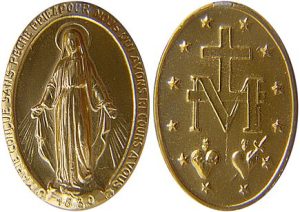
St. Catherine Laboure was granted her vision of Mary Immaculate on November 27, 1830. She viewed both the front and the back of the frame in which Mary appeared. The back of the frame showed a circle of twelve stars, recalling the vision of Saint John in the Book of Revelation (12:1); a large letter M surmounted by a cross, and the stylized Sacred Heart of Jesus crowned with thorns and Immaculate Heart of Mary pierced with a sword. Catherine heard Mary tell her to fashion after the image a medal which would provide protection and fill with grace those who wore it.
With approval of the Church, the first Medals were made in 1832 and were first distributed in Paris; then, to millions around the world. Countless wonders came to those who wore it: health was restored; bad habits were overcome; dangers were averted; men survived war and pestilence; and thousands were converted to the True Faith. People began to call it the “Miraculous Medal” — the official title it now bears in the liturgical feast that was established to honor the Queen Mother who gave it to us. Its greatest miracles are those of patience, forgiveness, repentance, and faith. God uses the Medal, not as a sacrament, but as an agent, an instrument, in bringing to pass certain marvelous results.
.
November 30
St. Andrew
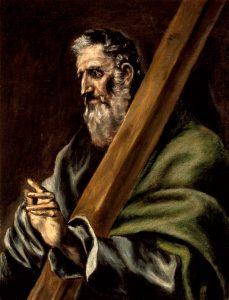
Andrew was the brother of St. Peter and, with his younger brother Peter, was called by Jesus to become a “fishers of men” and apostles. In early tradition, Andrew is said to have been born around 6 BC in a town called Bethsaida on the Sea of Galilee. Both he and his brother were fishermen on that sea. As with most of the apostles, little is said of him in the Gospels.
After the crucifixion and resurrection of Jesus, Andrew is said to have preached in Scythia and Thrace, along the shores of the Black Sea and the Dnieper River; he is honored today as the patron saint of the church in Ukraine. Andrew was martyred in Achaea, on the Greek peninsula. He was tied to an “X” shaped cross in the city of Patras, from which he preached for two days before succumbing.

